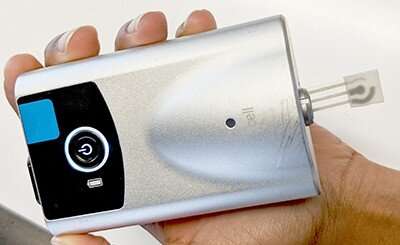A hand-held device combined with a touch sweat sensor (strip at right) measures glucose in sweat, while a personalized algorithm converts that data into a blood glucose level. Credit: ACS Sensors (2021). DOI: 10.1021/acssensors.1c00139
Many people with diabetes endure multiple, painful finger pricks each day to measure their blood glucose. Now, researchers reporting in ACS Sensors have developed a device that can measure glucose in sweat with the touch of a fingertip, and then a personalized algorithm provides an accurate estimate of blood glucose levels.
According to the American Diabetes Association, more than 34 million children and adults in the U.S. have diabetes. Although self-monitoring of blood glucose is a critical part of diabetes management, the pain and inconvenience caused by finger-stick blood sampling can keep people from testing as often as they should. Scientists have developed ways to measure glucose in sweat, but because levels of the sugar are much lower than in blood, they can vary with a person's sweat rate and skin properties. As a result, the glucose level in sweat usually doesn't accurately reflect the value in blood. To obtain a more reliable estimate of blood sugar from sweat, Joseph Wang and colleagues wanted to devise a system that could collect sweat from a fingertip, measure glucose and then correct for individual variability.
The researchers made a touch-based sweat glucose sensor with a polyvinyl alcohol hydrogel on top of an electrochemical sensor, which was screen-printed onto a flexible plastic strip. When a volunteer placed their fingertip on the sensor surface for one minute, the hydrogel absorbed tiny amounts of sweat. Inside the sensor, glucose in the sweat underwent an enzymatic reaction that resulted in a small electrical current that was detected by a hand-held device. The researchers also measured the volunteers' blood sugar with a standard finger-prick test, and they developed a personalized algorithm that could translate each person's sweat glucose to their blood glucose levels. In tests, the algorithm was more than 95% accurate in predicting blood glucose levels before and after meals. To calibrate the device, a person with diabetes would need a finger prick only once or twice per month. But before the sweat diagnostic can be used to manage diabetes, a large-scale study must be conducted, the researchers say.
More information: Juliane R. Sempionatto et al. Touch-Based Fingertip Blood-Free Reliable Glucose Monitoring: Personalized Data Processing for Predicting Blood Glucose Concentrations, ACS Sensors (2021). DOI: 10.1021/acssensors.1c00139
Journal information: ACS Sensors
Provided by American Chemical Society























